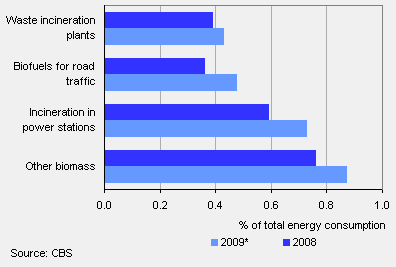Share of renewable energy up to 4 percent

Renewable energy accounted for approximately 4 percent of total domestic energy consumption in the Netherlands last year versus 3.4 percent in 2008. The fastest growing renewable energy sources were biomass and wind energy. The Dutch government aims at a 20 percent contribution of renewable energy in 2020.
Renewable energy replacing fossil primary energy sources

Subsidies promote consumption of renewable energy
In the period 1990-2003, the consumption of renewable energy grew from 0.7 to 1.5 percent of total energy consumption, i.e. an increase by less than 0.1 percentage points annually. After 2003, the use of renewable energy is growing much more rapidly by an average 0.4 percentage points annually. The increase is partly caused by the introduction of a subsidy scheme (Environmental quality Electricity Production) to promote generation of electricity in an environmentally-friendly manner.
More biomass
The contribution of biomass to energy supply grew from 2.1 percent in 2008 to 2.5 percent in 2009. The increase was realised by incineration of biomass in large power stations and the use of biofuels in road traffic. Other methods to use biomass also increased.
Biomass replacing fossil primary energy sources

Incineration of biomass in power stations accounted for 30 percent of all renewable energy generated from biomass in 2009. Biofuels contributed 20 percent to road traffic. Waste incineration plants accounted for 15 percent of renewable energy from biomass. The remaining part was the result of middle-sized and small-scale applications, e.g. incineration of waste wood, biogas installations and wood-burning stoves.
More wind energy
Energy generated by wind turbines accounted for over 1 percent of energy consumption in 2009. Wind turbines produced 10 percent more energy than in the previous year, despite the fact that 2008 was less windy. The increase is attributable to the use of new, large, state-of-the-art wind turbines.
Reinoud Segers and Marco Wilmer